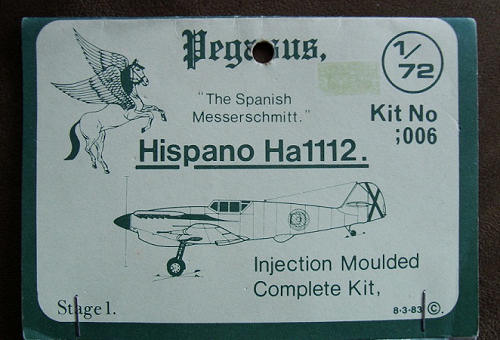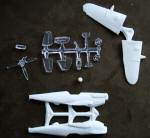
| KIT #: | 006 |
| PRICE: | NZ $25.00 (on line auction) |
| DECALS: | None |
| REVIEWER: | Zac Yates |
| NOTES: | Long out of production and very short run. |

| HISTORY |
During the Second World War, Spain was keen to build (under licence) the very
successful Messerschmitt
Bf109
fighter, and thus an agreement was entered into which would see the airframes of
several Bf109G-2s shipped to Spain for assembly by Hispano Aviacion with
Daimler-Benz engines (as well as weapons, instruments and other miscellaneous
components) also coming from Germany. In the event, however,
Eventually, by 1954 it was decided to trial a new development fitted with a
Rolls-Royce Merlin. This version entered production as the HA-1112-M1L, with
about 170 units being delivered. Due to the deep “chin” cowling the aircraft
earned the nickname of Buchón, this
being a deep-breasted pigeon native to
The film-star Buchóns were then sold off, four being purchased by members of the
Today around half a dozen remain airworthy, with another few under active
restoration to fly. A couple of Buchóns are on display in
| THE KIT |
 Not
many kits of the Buchón have been produced as far as I’m aware, those around
being the
Not
many kits of the Buchón have been produced as far as I’m aware, those around
being the
This is not a shake-and-bake, weekend kit by any stretch of the imagination.
Opening the bag, which I might add had been unopened since being stapled shut in
1983 after leaving Pegasus, out comes three sprues and some
sadly loose or broken parts. No decals are provided, the instruction list is
printed on the header card and a 1:72 three-view showing placement of national
insignias is provided. Recommended paints by Compucolour(?) are listed as are
sources of decals.
The fuselage halves make up one white sprue, the wings another, and other sundry
parts being on a third, clear sprue. The wings are provided as left and right
parts, each one piece, with the characteristic cannon fairings and wing fences
moulded on. Wheel wells are very shallow, which is odd as the entire wing is
very thick. Speaking of thick, the sprues and gates are massive, and it will
take a razor saw to separate parts from the sprues. It would be wise to – where
possible – scrounge around your spares box or cannibalise a Bf109 kit for the
undercarriage in case the provided units are broken when being separated. The
vertical stabiliser and rudder are one piece and moulded on the clear sprue
rather than on the fuselage halves, as are the horizontal stabilisers, seat,
wheels, one-piece canopy and the one-piece undercarriage leg and covers. The
pointed spinner and four-blade prop – another single-piece unit – was also
originally on the clear sprue but somewhere along the road had broken off and
one blade gone missing! The remaining three were also broken off at the root,
however this can be excused as it has been travelling the world since its birth
27 years ago!
In all there are fifteen parts, all with considerable flash. Surface detailing is actually quite nice and will look great under a coat of paint, however the wings will need a fair amount of sanding and then the detail will be lost. Interior detailing is limited to some raised lines which don’t seem to correspond to anything I’ve seen of a 109...the same can be said of the legend “Chris 83” engraved in the right fuselage half!
| CONCLUSIONS |
I was over the moon to receive this kit after my successful bid, and then
quite shocked and disappointed to see the kit itself. But as I look at it
more I see it more as a challenge – don’t tell my manager but I spent the
last couple of work shifts thinking about the kit – wondering how I can
tackle this. I’m torn between building the kit as it is, or cutting away the
nose and mating it to an Academy Bf109G-2. Stay tuned!
In short, this kit is doable, but not for the faint-hearted or the newbie...if
you can find it!
| REFERENCES |
December 2006
If you would like your product reviewed fairly and quickly, please contact me or see other details in the Note to Contributors.